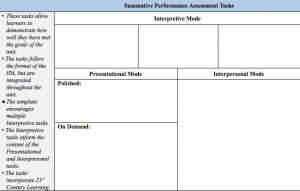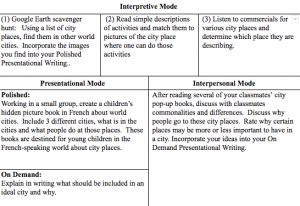
A How-To Guide to Planning Thematic Units – Step 4: Creating Unit IPAs
Greetings language educators! Here in Chicago we seem to be entering our 23rd month of winter and it’s hard for everyone to get motivated. When I first set out to write this series of posts on thematic unit planning, I thought I would add to it every other day…but I didn’t quite live up to my goal. It has become more of a “weekly” post 🙂
Let’s review what I’ve covered thus far. Click on the titles below to read my previous posts:
Step 2: Writing an essential question
Step 3: Determining unit goals
Step 4 is to create your unit IPAs. One could write a whole book about this topic. In fact, there are several excellent books you can use to get in depth information on preparing and implementing IPAs. “Implementing Integrated Performance Assessment” by Bonnie Adair-Hauck, Eileen W. Glisan, and Francis J. Troyan and “The Keys to Assessing Language Performance: Teacher’s Manual” by Paul Sandrock are both published by ACTFL and available for purchase on their website. Let me give a little summary here to help you get moving. Let’s begin by looking at the IPA portion of the unit template by Clementi and Terrill:

When filling in this portion, you should look at your unit goals. Since your goals were created with the World Readiness Standards in mind, your IPAs will as well. So ask yourself: What will your students DO to show that they have achieved the goals? What REAL-WORLD tasks can they undertake to help them answer the essential unit question?
I cannot stress how important this step is to accomplish at this point in your unit planning. I have to say that I did not always plan with this backward design model and I have learned how important it is. All of your scaffolded unit activities lead to the unit IPAs. And I have learned that the unit IPAs also are part of the learning process. One leads into another and then into another. With IPAs, I think the “I” is what gets lost a lot. Integrated. These should not all be end-of-unit exams; they need to be interspersed throughout the unit.
Here is an example of the assessment tasks that I am using in my novice-mid level city unit:

Begin with the Interpretive Mode tasks. These tasks involve interpreting written, spoken or visual authentic texts. Remember that an authentic text is one that is produced by native speakers for native speakers. Examples of authentic texts can be stories, poems, infographics, songs, art, articles, cartoons, movies, podcasts, etc. in the target language. And don’t think that your novice students can’t handle authentic resources-they can! You, the teacher, need to make the task accessible to a novice level student.
The assessments above use authentic texts, but the tasks are easily manageable my novice students. Notice also, how the pictures found in the Google Earth Scavenger Hunt will be used in the Polished Presentational task.
The Presentational Mode assessments have both a “Polished” and an “On Demand” task. The Polished tasks allow the students to work together to create a public performance. It can be written or spoken or both. The On Demand task shows what students can do without the aid of notes or editing. In my polished assessment, students will work together to make a children’s book, using the pictures from an interpretive task. The on demand task will be implemented after they accomplish the interpersonal mode.
The Interpersonal Mode allows the students to talk with each other with purpose. The conversation is unrehearsed and unwritten. In my example, students will discuss their children’s books that were completed in the presentational mode. In the discussion, they will determine which places are most important to have in a city. And then this leads to the on demand presentational mode task.
I am really happy with the way that these IPAs are really Integrated Performance Assessments. They follow from the unit goals and allow the student to answer the essential question, “What makes an ideal city?”
Next step: Connecting your unit to the Standards.
Until then…If you have any questions or comments, please send me an email. I’d love to hear form you! Contact me at: jesuismsmadame@gmail.com


